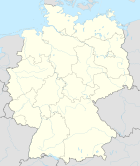Balzhausen
| coat of arms | Germany map | |
|---|---|---|

|
Coordinates: 48 ° 15 ' N , 10 ° 30' E |
|
| Basic data | ||
| State : | Bavaria | |
| Administrative region : | Swabia | |
| County : | Gunzburg | |
| Management Community : | Thannhausen | |
| Height : | 516 m above sea level NHN | |
| Area : | 14.63 km 2 | |
| Residents: | 1200 (Dec. 31, 2019) | |
| Population density : | 82 inhabitants per km 2 | |
| Postal code : | 86483 | |
| Area code : | 08281 | |
| License plate : | GZ, KRU | |
| Community key : | 09 7 74 115 | |
| LOCODE : | DE BZA | |
| Community structure: | 2 parts of the community | |
| Association administration address: | Christoph-v.-Schmid-Str. 7 86470 Thannhausen |
|
| Website : | ||
| First Mayor : | Daniel Mayer ( CSU / Free Voters) | |
| Location of the municipality of Balzhausen in the district of Günzburg | ||
Balzhausen is a community and a parish village in the Swabian district of Günzburg and a member of the Thannhausen administrative community .
geography
Balzhausen is located in the Donau-Iller region.
There are two officially named parts of the municipality (the type of settlement is given in brackets ):
Only the Balzhausen district exists .
history
Until the church is planted
Archaeological evidence shows that there was a brick factory in Balzhausen during Roman times.
Balzhausen was first mentioned in a document in 956. Since the Middle Ages, the margravate Burgau was sovereign, to which the local rule Seifriedsberg belonged. During the Peasants' Wars , farmers conquered Balzhausen and several small towns, including Thannhausen, in February 1525 . An army campaign from Ulm inflicted a devastating defeat on this heap of farmers on May 31, 1525, as a result of which the towns of Burg and Balzhausen were burned down. Balzhausen belonged to the Counts of Oettingen-Wallerstein . It is part of the Seifriedsberg rule since 1751. With the Rhine Confederation Act 1806, the place came to the Kingdom of Bavaria . In the course of the administrative reforms in the Kingdom of Bavaria, today's municipality was created with the municipal edict of 1818 .
Population development
- 1961: 901 inhabitants
- 1970: 930 inhabitants
- 1987: 971 inhabitants
- 1991: 1034 inhabitants
- 1995: 1123 inhabitants
- 2000: 1224 inhabitants
- 2005: 1209 inhabitants
- 2010: 1184 inhabitants
- 2015: 1234 inhabitants
Between 1988 and 2018 the municipality grew from 964 to 1,209 by 245 inhabitants or 25.4%.
politics
mayor
Mayor was Gerhard Glogger (CSU / Free Voters) from 1996 to 2014. The new mayor is Daniel Mayer. He has been in office since 2014 and was elected on March 15, 2020 as the only candidate with 71.6% of the vote for a further six years.
Municipal council
In the local council elections in 2002, all twelve seats went to the single nomination, the list of CSU / Free Voters.
Since the last election in 2014, the municipal council has been composed as follows:
Eight seats are allocated to the CSU / FW parliamentary group, local councilors are: Adelinde Baur (2nd mayor), Wolfgang Neu, Herbert Wieser, Stefanie Schütz, Christian Haugg, Michaela Leinweber, Wolfgang Bollinger and German Knoll.
Four seats are allocated to the BNL (Balzhauser Neue Liste) parliamentary group, local councilors are: Klaus Langhans, Monika Ritter, Herbert Scheffler and Robert Wank.
In the local elections on March 15, 2020 , only nominations were submitted, jointly by CSU / Free Voters, who received all 12 seats in the local council.
badges and flags
|
Blazon : “Split by a golden pole in green and red; in front a silver house with a golden roof, behind a floating silver paw cross. "
The white-green-yellow municipal flag approved at the same time is not used. |
|
Economy and Infrastructure
Economy including agriculture and forestry
In 1998, according to official statistics, there were 286 in the manufacturing industry and in the trade and transport sector no employees subject to social security contributions at the place of work. In other economic sectors 33 people were employed at the place of work subject to social security contributions. There were a total of 404 employees at the place of residence subject to social security contributions. There were none in the manufacturing sector and two in the construction sector. In addition, in 1999 there were 44 farms with an agriculturally used area of 975 ha, of which 402 ha were arable land and 574 ha were permanent green space.
The trade tax multiplier is currently 310%.
education
In 2007 the following facilities existed:
- Kindergarten: 50 kindergarten places with 41 children
- Primary school: one with eight teachers and 130 students
- SVE (preparatory school): 40 places; currently about 36 children
Web links
Individual evidence
- ↑ "Data 2" sheet, Statistical Report A1200C 202041 Population of the municipalities, districts and administrative districts 1st quarter 2020 (population based on the 2011 census) ( help ).
- ^ Municipal Council> Members. Balzhausen community, accessed on May 26, 2020 .
- ^ Community Balzhausen in the local database of the Bavarian State Library Online . Bayerische Staatsbibliothek, accessed on August 30, 2019.
- ↑ Ulrich Brandl, Emmi Federhofer: Sound + Technology. Roman bricks. Theiss, Stuttgart 2010, ISBN 978-3-8062-2403-0 ( publications from the Limes Museum Aalen. No. 61)
- ↑ Burg district , on vg-thannhausen.de. Retrieved September 5, 2015
- ↑ Entry on the Balzhausen coat of arms in the database of the House of Bavarian History
- ↑ Entry on Balzhausen on the Kommunalflaggen.eu page







